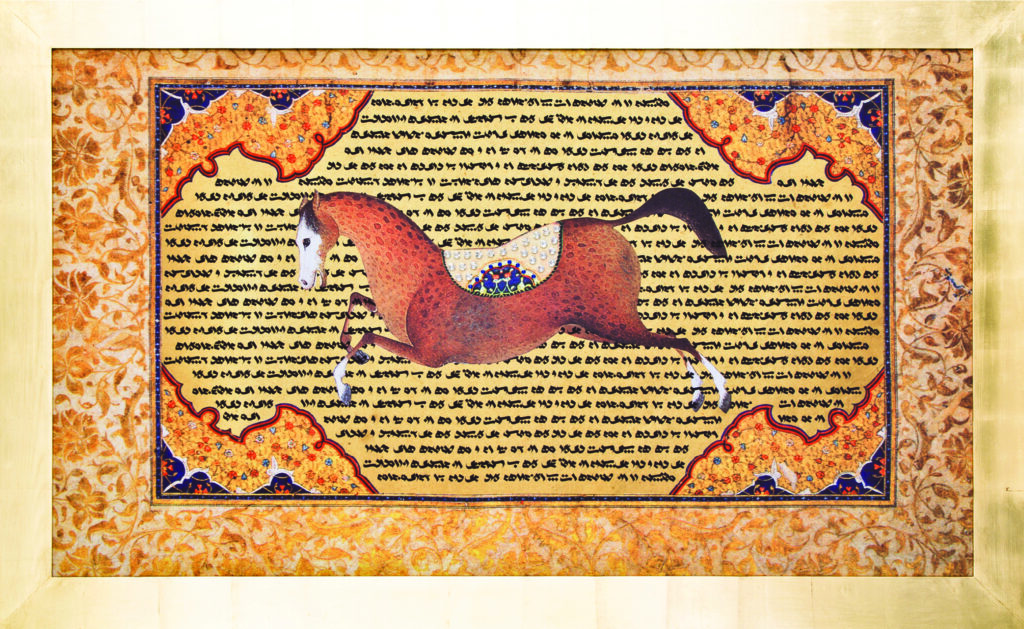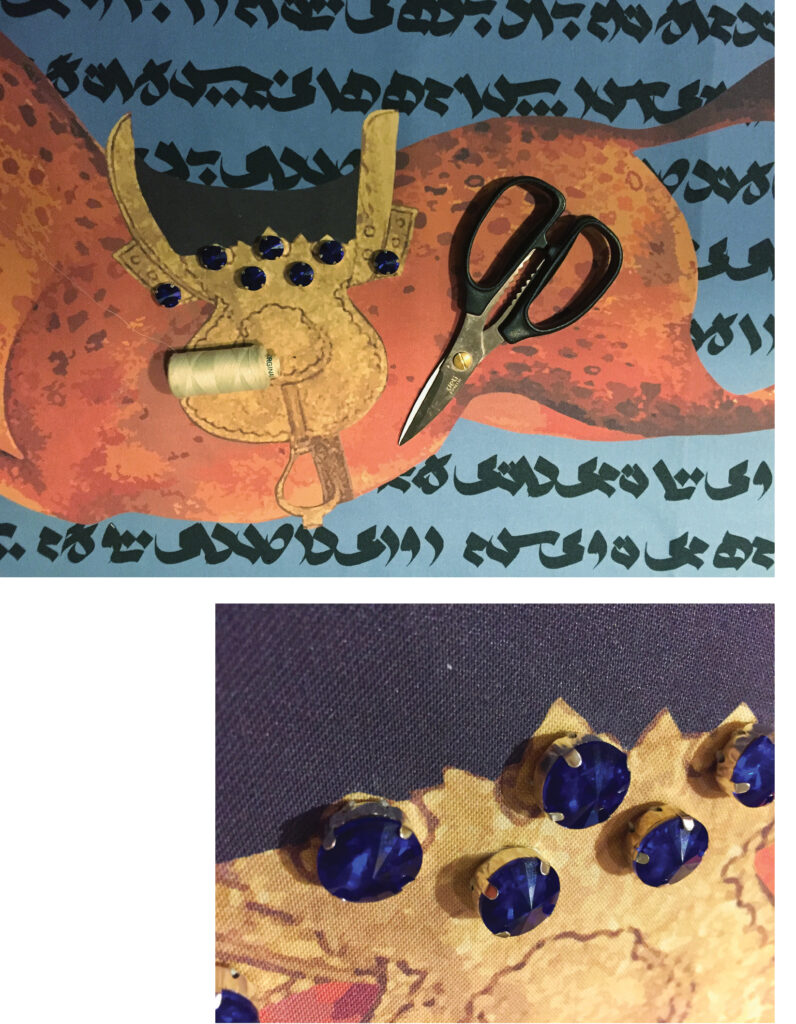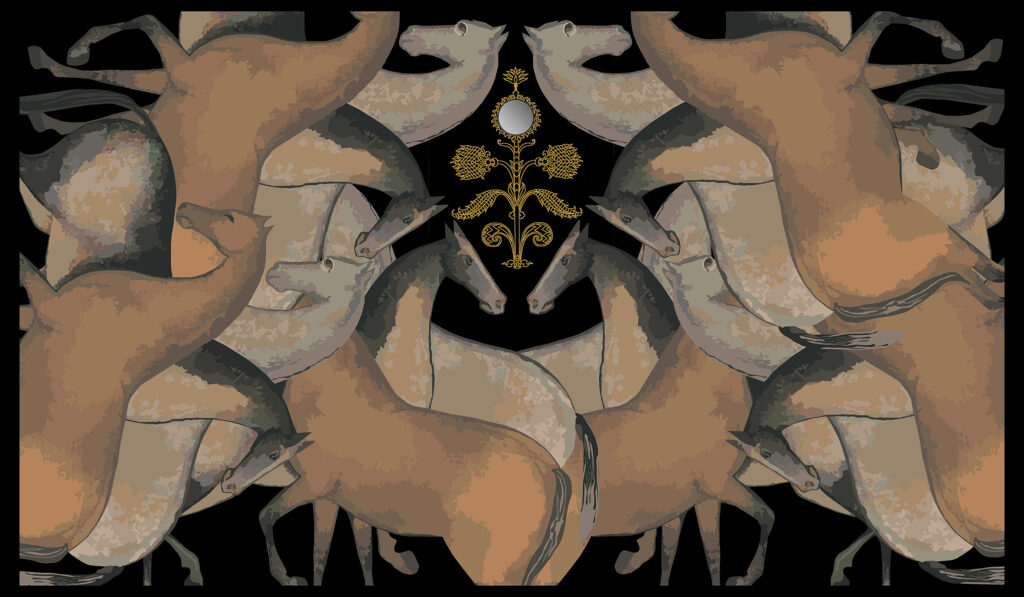Digital painting, print on textile, 2012 – 2020
Old Iranian miniatures, are often filled with men and women and horses; Women, men and horses are side by side, facing each other, intertwined, fighting, traveling, dancing and rejoicing. For example, look at this painting, it is filled with men and women playing and dancing, royal cupbearers, soldiers and harem women all over it. At the top of the image and slightly tilted to the right Sultan Husayn Bayqara is sitting on the porch of the palace. Sultan Husayn is taking wine from the hand of his cup bearer and the cup is still somewhere between the hands of them. We know Sultan Hossein: Sultan Husayn Bayqara was the Timurid ruler of Herat from 1469 until 1506. A skilled statesman and was best known for his interest in the arts and was renowned as a benefactor and patron of learning in his kingdom. We know his vizier very well, too. Ali-Shir Nava’i was born in 1441, he was a Timurid poet, writer, statesman, linguist, mystic and painter. We also know that the painter did not paint Alishir Nawai at the Sultan’s luxury feast, because he was a famous Sufi and no one likes to see a holy-man drinking wine in an Islamic empire. It is so that the painter has deliberately included the void of the presence of the famous court minister of Sultan Hossein in his painting; Because in other available paintings from Sultan Hussein’s court, Ali-Shir Nava’i can be seen in the picture.
We do know these two people. But what about the rest? In this picture, except for the Sultan, thirty-six men and women are depicted, and we do not know the names of any of them.
who are they? They are soldiers or dancers or harem women or servants. They have no name. They are simply peripheral to the text of the image of the Sultan. History has taught us to call them “people”. A simple word that allows us to ignore the entire history of a person’s life. It was in 2010 when I noticed this point in Iranian paintings for the first time. After that I went to the horses. Horses are subject to the same rule. I looked at pictures of wars. In countless paintings, we see that Rustam, the most famous legendary hero of Iran, is fighting on the back of his horse. We even know the name of his horse. We know how Rustam got his horse and we know what character his horse has. But what about the rest? Those horses are only there to make the picture more magnificent. Just like people. That’s when I thought of this title: We are the small people of the big event. A little later I started removing the horses from the pictures. I put the horses in the center of the picture. without a rider. No weapons. without a war without a whip falling on their sides. I painted horses who were the central characters of their paintings. And then I wrote their wishes. Something from the horse’s tongue that came out of the old image and was placed in a new one. I preferred that these wishes, these monologues, should not be read. With the help of a friend, we designed a font that is not readable. This is how the first pieces of this series were made. Of course, when the buyers bought those pieces, readable text was provided to them. For me, these horses are icons that represent “us”. That symbolic “us” that is always opposed to “them”.
It was from then that year after year in every social crisis, in every national happiness and in every disaster, I drew a new horse. And she was always the heart of the picture, alone or with her friends. This is a human desire; A world belonging to the people. A world that still does not exist outside the world of art.



Similar to his previous pieces, in his ornamented horses of the series Burn these leaves he invents signs and codexes, uses some existing ones and also appoints you to carry your own text or existence to shape the entirety of the piece. The road to be a confidant of his works once was too harlequin a snake that slithered her way in elegant complexity. Amazingly he has managed to change this steep and swirling road into a contract. The background text of each work, meticulously designed to be hard-to-read is revealed in a secret box that is send to the confidant that owns the artwork. His art has previously selected his audience and confidant due to their ability to reveal different sides of a secret hence be the secret keeper of the pervert couple now he has transformed this subjectivity into something that is more objective and has the potential to be a property of an owner.
-Kiarash Alimi-





Digital painting, digital print on textile, embroideries and mirror work


